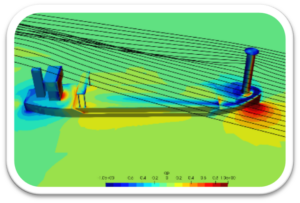CFD, FlettnerFLEET and MS “Annika Braren”
Every kind of aerodynamic research of surface vessels is generally carried out numerically at HSVA. Usually, either purely statistical approaches (Unsteady Reynolds Averaged Navier-Stokes, URANS) or hybrid, statistical and partially scale-resolving (RANS, Large-Eddy Simulation, RANS-LENS) models are used to simulate the turbulent air flow. The hybrid approach in particular has a qualitatively and quantitatively outstanding prediction quality, however, the extremely fine descriptions in space (i.e. computational grid) and time (i.e. time steps) required for this, combined with comparatively long convergence times, result in high simulation costs which appear disproportionately high in a relatively early design stage.
A predominant goal of the work at the HSVA therefore addresses the development of a significantly less complex simulation method which transfers ideas from hydrodynamic design (first frictionless wave resistance analysis, then (U)RANS) to aerodynamic design. For this purpose, a frictionless, so-called Eulerian simulation method is being developed, which procedurally shows great similarities with typical RANS simulations at the HSVA but should provide adequate results due to the presence of relatively large Reynolds numbers while simultaneously considering lift effects. Switching of walls with no-slip condition to slip-walls allows for example the negligence of boundary layer grid refinements and results in an enormous reduction in the size of the computational grids required for the calculation. However, the messing adhesion condition now makes it difficult to impose the fluid rotation induced by Flettner rotors. For this reason, a special volume force model was developed which iteratively adjusts the initially unknown volume force to the region above the rotor wall with the aid of a control loop in such a way that it ultimately results in a rotor speed given circulation distribution.
Together with the more complex hybrid RANS-LENS method, the “Annika Braren” was examined aerodynamically. In addition to validating the newly developed, less complex simulation method, the investigations where aimed at supporting the installation of a LIDAR system by the project partner IWES. On the basis of existing operating data, a suitable, representative operating point (speed, draught, wind speed, rotor speed, etc.) was determined, for which simulations of six true wind angles (0,15, 45, 90, 135, 180 degrees) were then carried out. Time-averaged simulation results of the scale-resolving RANS-LES simulations were provided to IWES in Virtual Toolkit (VTU) format for analysis and LIDAR installation support, see the following figure.

Figure 1: Pressure coefficient and streamlines with starboard wind and active rotor for a simplifies overwater geometry of the “Annika Braren”


